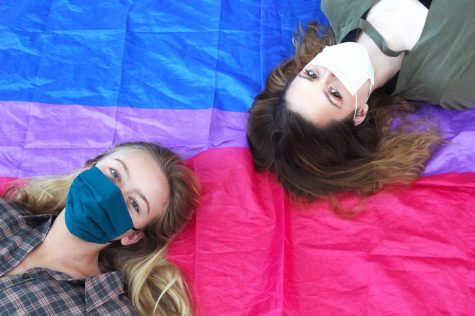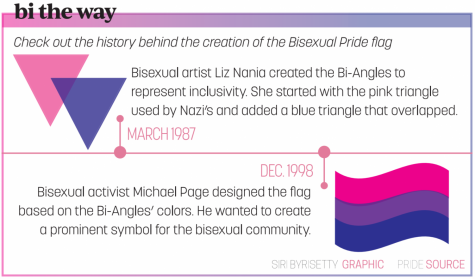
President of the Gender and Sexuality Alliance Club (GSA) and junior Marielle Cortelyou, who identifies as bisexual, plans on baking heart-shaped sugar cookies decorated with the bisexual flag colors to celebrate Bisexual Pride Day, which is observed annually on Sept. 23.
“I made the cookies heart-shaped because hearts represent love,” she said, “and with the bisexual flag on them, I wanted them to take on the meaning of loving and supporting the bisexual community.”
According to GLAAD, a pro-LGBTQ media group, a bisexual individual is “a person who has the capacity to form enduring physical, romantic and/or emotional attractions to those of the same gender or to those of another gender.”

Licensed mental health counselor Amy Liptak said having specific days to celebrate sexualities and take pride in them positively impacts students.
“Just having that visibility—how powerful is it for an individual to see other people like them when they may not know anybody in real life who (identifies as bisexual)?” she said. “To walk into a room of allies and people who experience life the same way, is so powerful; it’s positive. ”
Cortelyou agrees, saying it was a validating occasion as it helps people get support from people in the community, and make new friends that one did not know were bisexual before.
“I think it’s awesome to have a specific (day),” senior Annie Salter, who identifies as bisexual, said. “I don’t think it’s something I needed, but it is something very rewarding to know, coming together to support other bi people in the community as well, and…every day should be a celebration of who you are.”
Sophomore Finn Inmon, who also identifies as bisexual, said that along with the validation that comes with a day celebrating bisexuality, it is also important as it offers more exposure of the bisexual community.
However, even though Cortelyou, Salter and Inmon said they had a lot of support when they came out, they said being bisexual came with discrimination and erasure.
Cortelyou talked about an incident in her engineering class, where she faced stigma from a fellow student who did not believe her sexuality to be real. When he heard she was bisexual, he responded in a fashion that highlighted a major stigma—that bisexuality as a concept does not exist, also known as bisexual erasure.
“I feel like that’s a really big stigma for girls in the community—that they are bi but (people) don’t believe that they actually are,” she said.
Inmon specified another stigma that a lot of bisexual people face: being labeled either “half-gay” or “half-straight” or any other subset of the two.
“The stigma (is) the idea that bisexual people either don’t exist or rarely exist, and when they do exist they’re eventually going to turn gay,” Inmon said. “The idea that you (don’t actually know you are bisexual), and that the people around you know more than you do, that can come from anywhere in the community, or outside of it. (It’s) invalidation: the idea that we don’t exist.”
There are other stereotypes that have found their way into the treatment of bisexuals. Salter said one of the most common stereotypes is the perception that coming out as bisexual is a trend, as a temporary label or a ploy to garner social media attention.

Salter said, “It’s kind of a big thing for me…I wouldn’t have faced the struggle of coming out to people that I wasn’t sure were going to accept me, if I thought this was just a fun trend. There is a lot in my life that I faced losing because of this and with that…(the) stigma really hurt.”
Regardless of the stigma, Inmon said being bisexual is something that did made them doubt themself at times. They talked about something colloquially known as the “bi cycle,” where bisexual people are attracted to different genders in varying proportions at different points in time.
“If (your attraction) leans (more toward one gender) than the other,” they said, “you’ll start to invalidate yourself because you think, ‘Oh if I’m leaning more this direction then I’m not attracted to these other genders…I’m not actually bisexual’…but just remember that it’s pretty common among bisexual people and you’re not alone.”
Cortelyou agreed, saying, “I think people need to understand that if you’re bi and in a straight relationship, you’re still bi. And if you are in a gay relationship, you are still bi.”
Liptak said her clients who identify as bisexual believe it is hard for other people to understand them. She said, “In my practice working with people and what I hear from their experiences…I think that we’ve had a hard time understanding how a person can be attracted to both a man and a woman.”
Despite the many stereotypes Cortelyou, Salter and Inmon said they faced, they said they were proud to be bisexual and celebrated their sexuality in the way they lived.
Salter said she was secure in her sexuality, even though people tend to dismiss bisexuality as something more controversial than being gay or straight.
“(A major stereotype is) the idea that we’re confused (about our sexuality),” Salter said. “I’m not, thank you, though, for being concerned about me. I don’t have to fit in one of your little boxes. I can be in between. It’s all right.”
Cortelyou, Salter, and Inmon said they received a lot of support from the school and their family and friends, even though isolated events of stigma and stereotyping still occurred.

Still, all interviewees agreed that more exposure to the topic of bisexuality is necessary. Liptak said education is what makes a difference in allies and other people, and there are a lot of resources online if one is ever confused and wants to take a look.
“To destigmatize, we’ve got to educate people, we’ve got to have that information out there and so people can understand that this…is not a human mental sickness or deviation,” Liptak said, “It’s just a part of human diversity.”
Inmon said another aspect of being a better ally to the community is by listening to peers in the LGBTQ community. They said it was important to have an open mind, and to understand that one never knows more about their peer’s experience than they themselves.
Liptak said clubs like the GSA at CHS are incredible at making students seen and heard. According to Cortelyou, when the GSA had their callout meeting, they had over fifty people turn up. She said it was heartening to see the interest and connection in these fifty students in a community that was important to all of them.
“Don’t be afraid to let your friends know (of your sexuality). Just tell people closer to you,” said Salter. “It was a big relief (to come out), and if you’re looking for that kind of relief and you’re ready to be honest with everyone else—and be honest with yourself—be brave and let others know who you are. The staff and students at this school are amazing; there’s plenty of support. If you can’t get it from your house (or) from your friends, you can get it at our school.

































![AI in films like "The Brutalist" is convenient, but shouldn’t take priority [opinion]](https://hilite.org/wp-content/uploads/2025/02/catherine-cover-1200x471.jpg)








































![Review: “The Immortal Soul Salvage Yard:” A criminally underrated poetry collection [MUSE]](https://hilite.org/wp-content/uploads/2025/03/71cju6TvqmL._AC_UF10001000_QL80_.jpg)
![Review: "Dog Man" is Unapologetically Chaotic [MUSE]](https://hilite.org/wp-content/uploads/2025/03/dogman-1200x700.jpg)
![Review: "Ne Zha 2": The WeChat family reunion I didn’t know I needed [MUSE]](https://hilite.org/wp-content/uploads/2025/03/unnamed-4.png)
![Review in Print: Maripaz Villar brings a delightfully unique style to the world of WEBTOON [MUSE]](https://hilite.org/wp-content/uploads/2023/12/maripazcover-1200x960.jpg)
![Review: “The Sword of Kaigen” is a masterpiece [MUSE]](https://hilite.org/wp-content/uploads/2023/11/Screenshot-2023-11-26-201051.png)
![Review: Gateron Oil Kings, great linear switches, okay price [MUSE]](https://hilite.org/wp-content/uploads/2023/11/Screenshot-2023-11-26-200553.png)
![Review: “A Haunting in Venice” is a significant improvement from other Agatha Christie adaptations [MUSE]](https://hilite.org/wp-content/uploads/2023/11/e7ee2938a6d422669771bce6d8088521.jpg)
![Review: A Thanksgiving story from elementary school, still just as interesting [MUSE]](https://hilite.org/wp-content/uploads/2023/11/Screenshot-2023-11-26-195514-987x1200.png)
![Review: "When I Fly Towards You", cute, uplifting youth drama [MUSE]](https://hilite.org/wp-content/uploads/2023/09/When-I-Fly-Towards-You-Chinese-drama.png)
![Postcards from Muse: Hawaii Travel Diary [MUSE]](https://hilite.org/wp-content/uploads/2023/09/My-project-1-1200x1200.jpg)
![Review: "Ladybug & Cat Noir: The Movie," departure from original show [MUSE]](https://hilite.org/wp-content/uploads/2023/09/Ladybug__Cat_Noir_-_The_Movie_poster.jpg)
![Review in Print: "Hidden Love" is the cute, uplifting drama everyone needs [MUSE]](https://hilite.org/wp-content/uploads/2023/09/hiddenlovecover-e1693597208225-1030x1200.png)
![Review in Print: "Heartstopper" is the heartwarming queer romance we all need [MUSE]](https://hilite.org/wp-content/uploads/2023/08/museheartstoppercover-1200x654.png)




